Analysis of Two Stroke Marine Diesel Engine Operation Including Turbocharger Cut-Out by Using a Zero-Dimensional Model
Abstract
:1. Introduction
2. Modular Engine Model Description
2.1. Model Structure
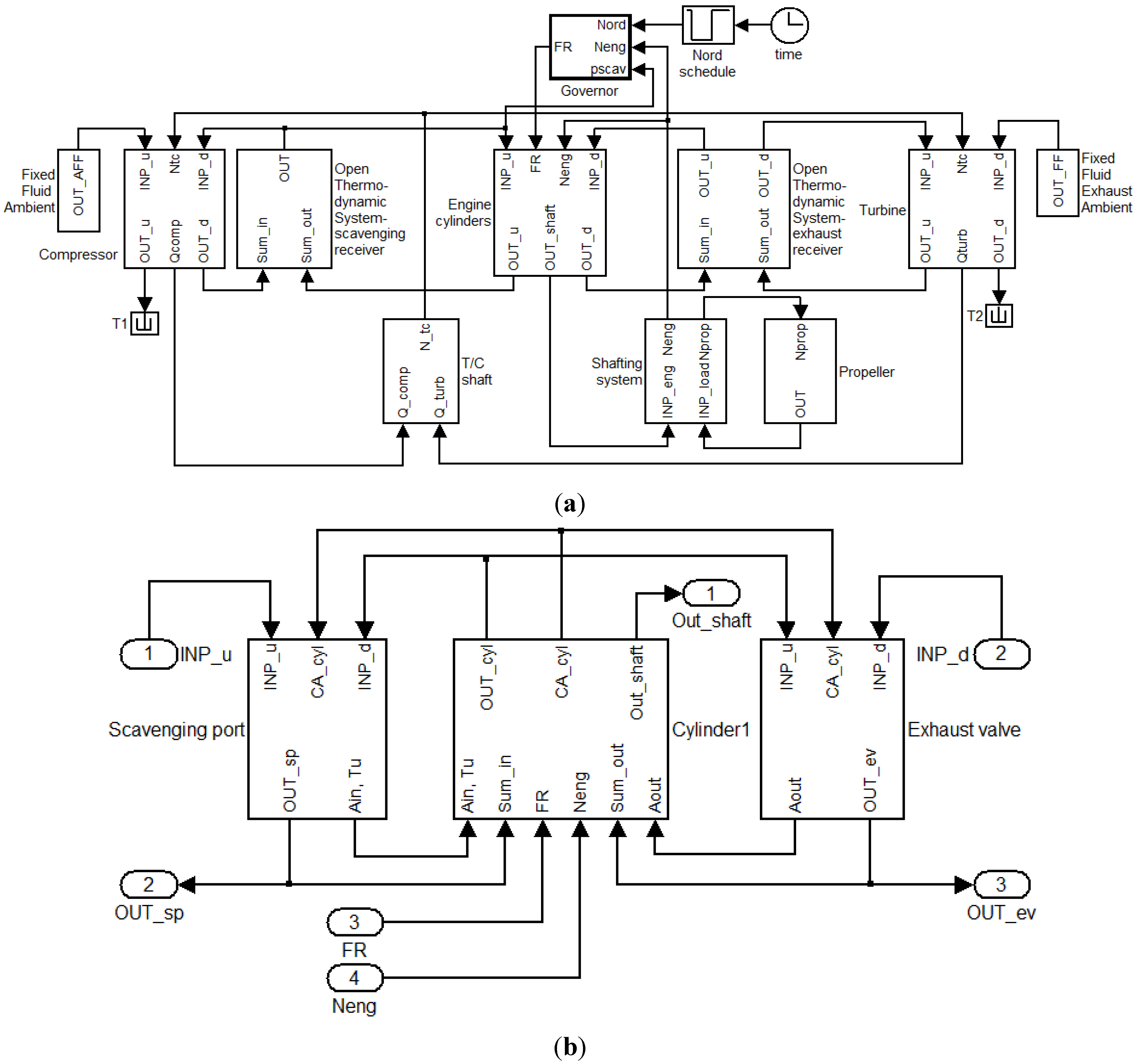
2.2. Governing Equations
2.2.1. Cylinder
2.2.2. Scavenging Ports/Exhaust Valve
2.2.3. Engine Receivers
2.2.4. Turbocharging System Components
- Divide the compressor map into zones depending on the available constant speed curves.
- Digitize the provided compressor performance map.
- Calculate the non-dimensional parameters for the digitised compressor operating points.
- Derive the values of the parameters for each zone using curve fitting techniques.
- Derive the equations interrelating the actual maximum compressor efficiency with speed and the non-corrected maximum compressor efficiency with speed using curve fitting techniques.
- Provide all the above parameters as input to the compressor model.
- Calculate the corrected speed and identify the respective compressor map zone.
- Calculate the non-dimensional parameters.
- Calculate the non-dimensional flow coefficient for the respective zone.
- Derive the compressor volumetric flow rate.
- Calculate the non-dimensional torque coefficient for the respective zone.
- Calculate the compressor torque.
- Calculate the non-corrected compressor isentropic efficiency.
- Derive the corrected compressor isentropic efficiency.
2.2.5. Shaft Elements
2.2.6. Governor Element
2.2.7. Model Set up and Parameters Calibration
- Select the component blocks which sufficiently represent the engine layout from the models library.
- Connect the component blocks with the required connections.
- Insert the input data in all the blocks.
- Preliminary calibration of the model constants for a reference point and carrying out simulation runs.
- Fine tuning the model constants to obtain the required accuracy.
3. Results and Discussion
3.1. Validation of Zero-Dimensional Model
| Bore | 980 mm |
|---|---|
| Stroke | 2660 mm |
| Number of cylinders | 7 |
| Brake power at MCR | 40,100 kW |
| Engine speed at MCR | 94 r/min |
| BMEP at MCR | 18.2 bar |
| Turbocharger units | 3 |



| Engine Load (% MCR) | 100 | 75 | 50 | 25 |
|---|---|---|---|---|
| Error (%) | ||||
| Brake power | −1.02 | −1.01 | −0.99 | −0.92 |
| BSFC | 0.16 | 0.55 | −0.08 | 0.18 |
| Maximum cylinder pressure | 0.71 | 0.07 | −1.46 | −0.59 |
| Cylinder compression pressure | 0.81 | −0.23 | −0.86 | −1.16 |
| Turbocharger speed | 0.03 | −0.41 | −1.47 | −4.52 |
| Scavenging air receiver pressure | 1.39 | 0.40 | −0.89 | −0.54 |
| Exhaust gas receiver pressure | −0.20 | −2.23 | −4.11 | −3.13 |
| Scavenging air receiver temperature | −0.72 | −0.39 | −0.45 | −0.24 |
| Exhaust gas receiver temperature | 0.46 | 0.48 | 1.08 | −0.37 |
| Exhaust gas temperature after turbocharger | 2.52 | −1.18 | −0.99 | −3.25 |
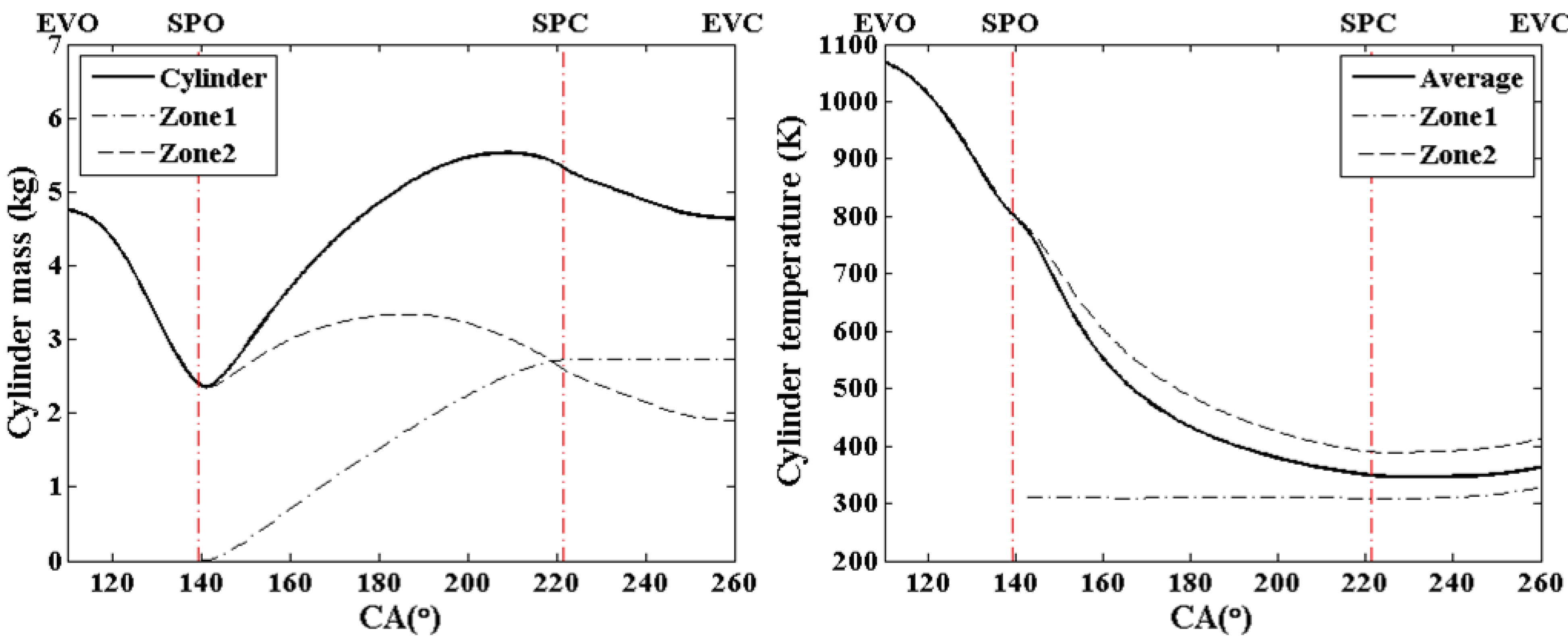
3.2. Engine Operation Investigation with Turbocharger Cut-Out
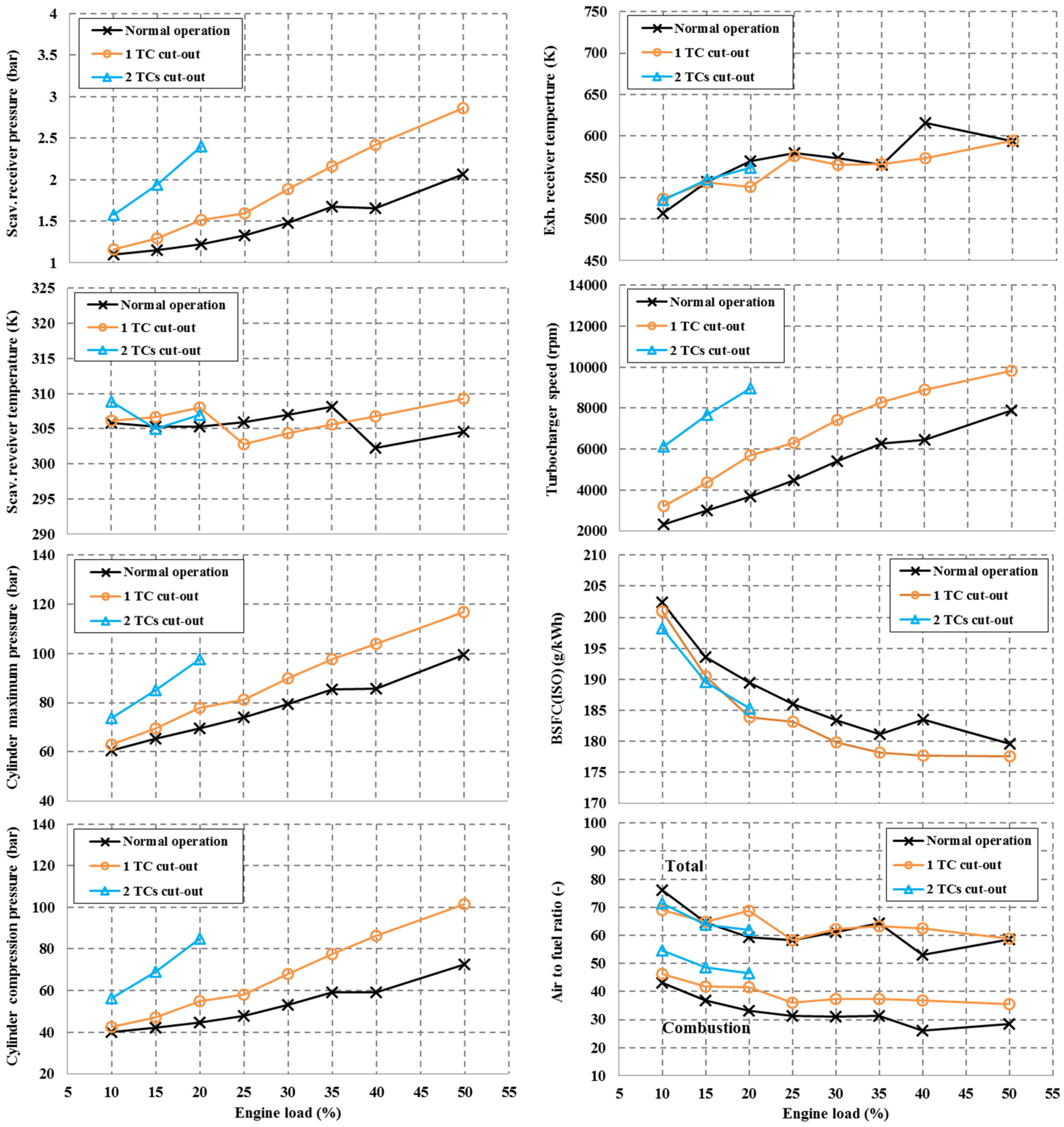
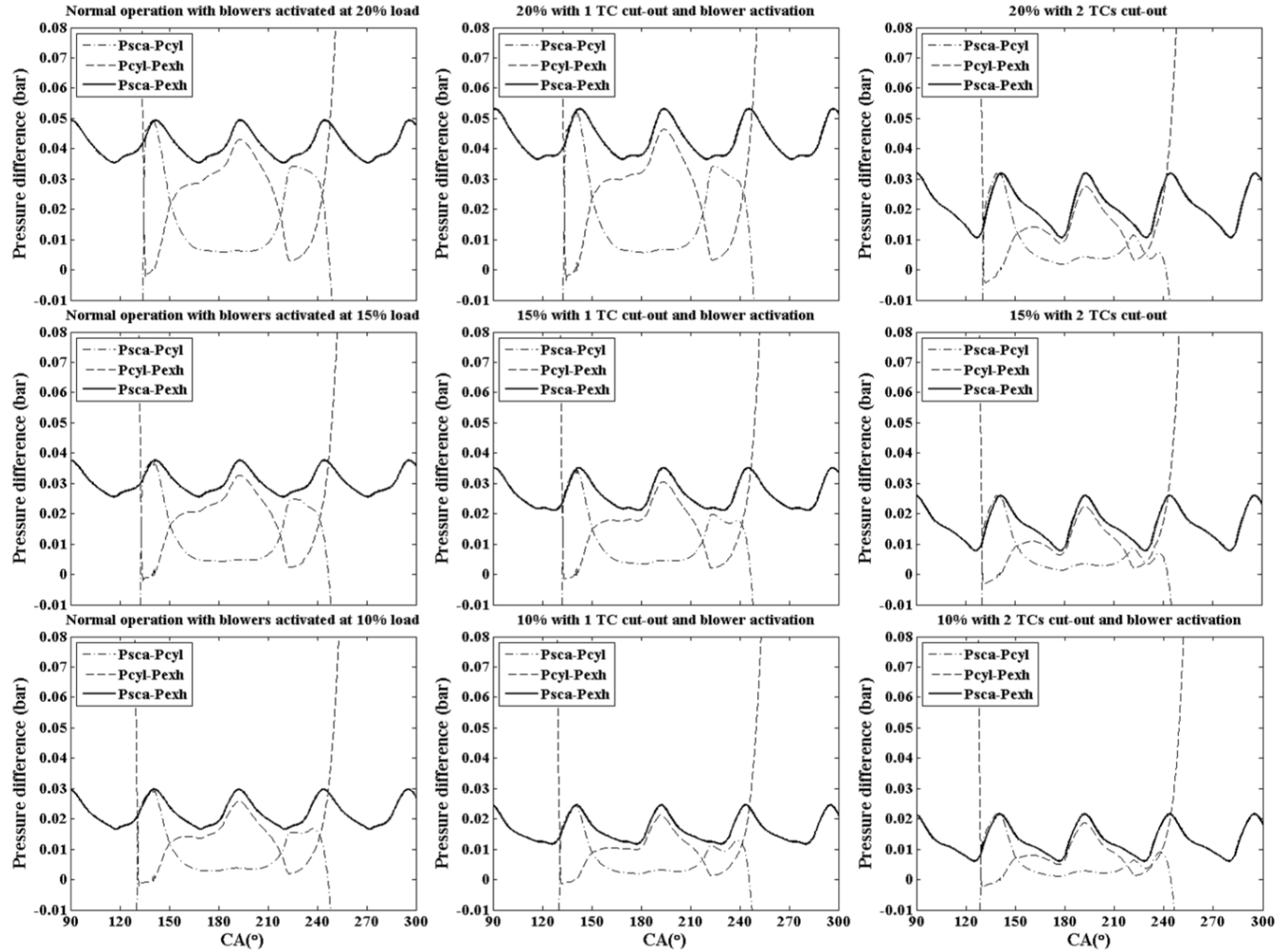

- From 50% to 25% load, one turbocharger cut-out without blower activation.
- From 20% to 15% load, two turbochargers cut-out without blower activation.
- In the region of 10% load, two turbochargers cut-out with blower activation.
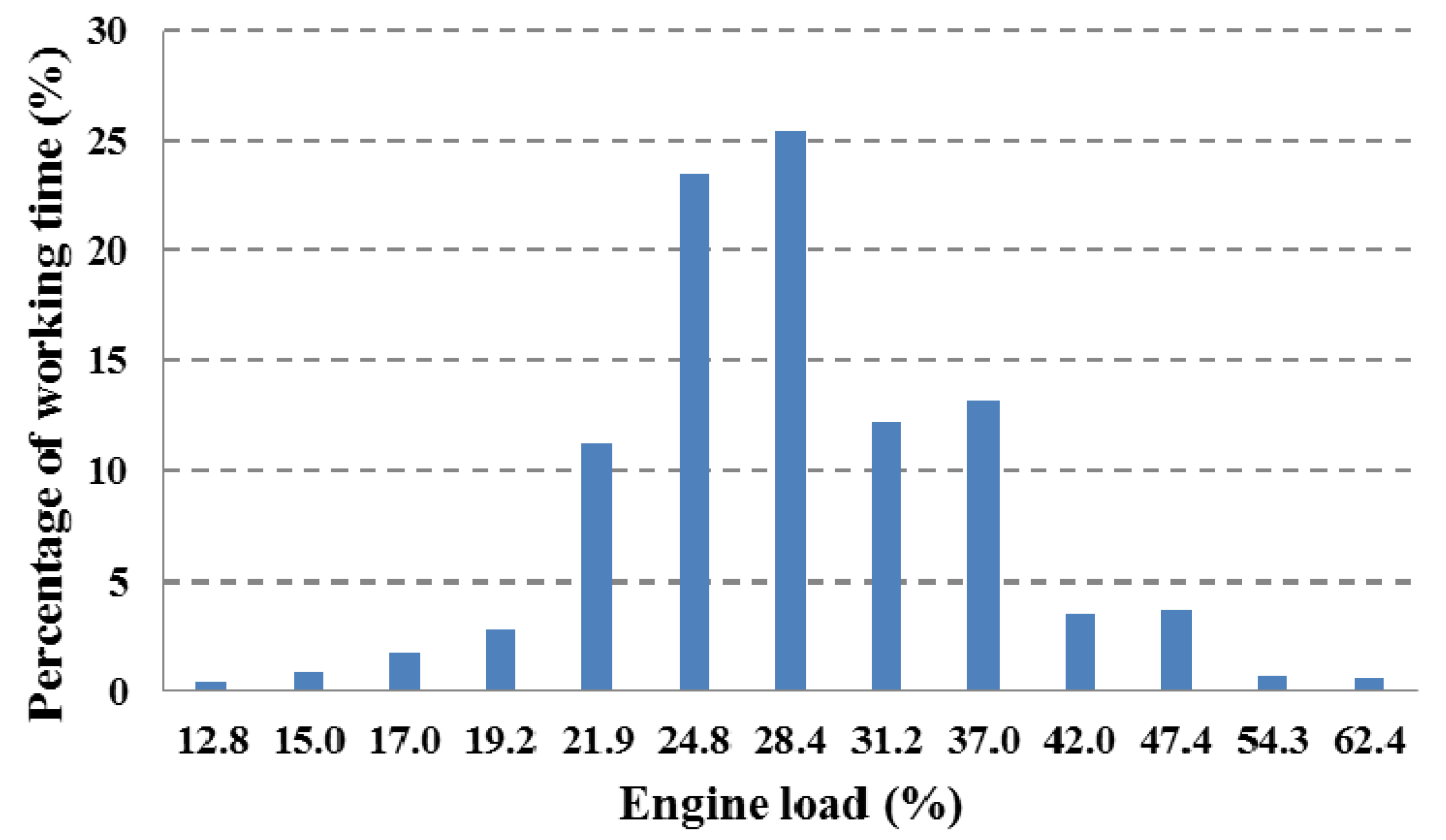

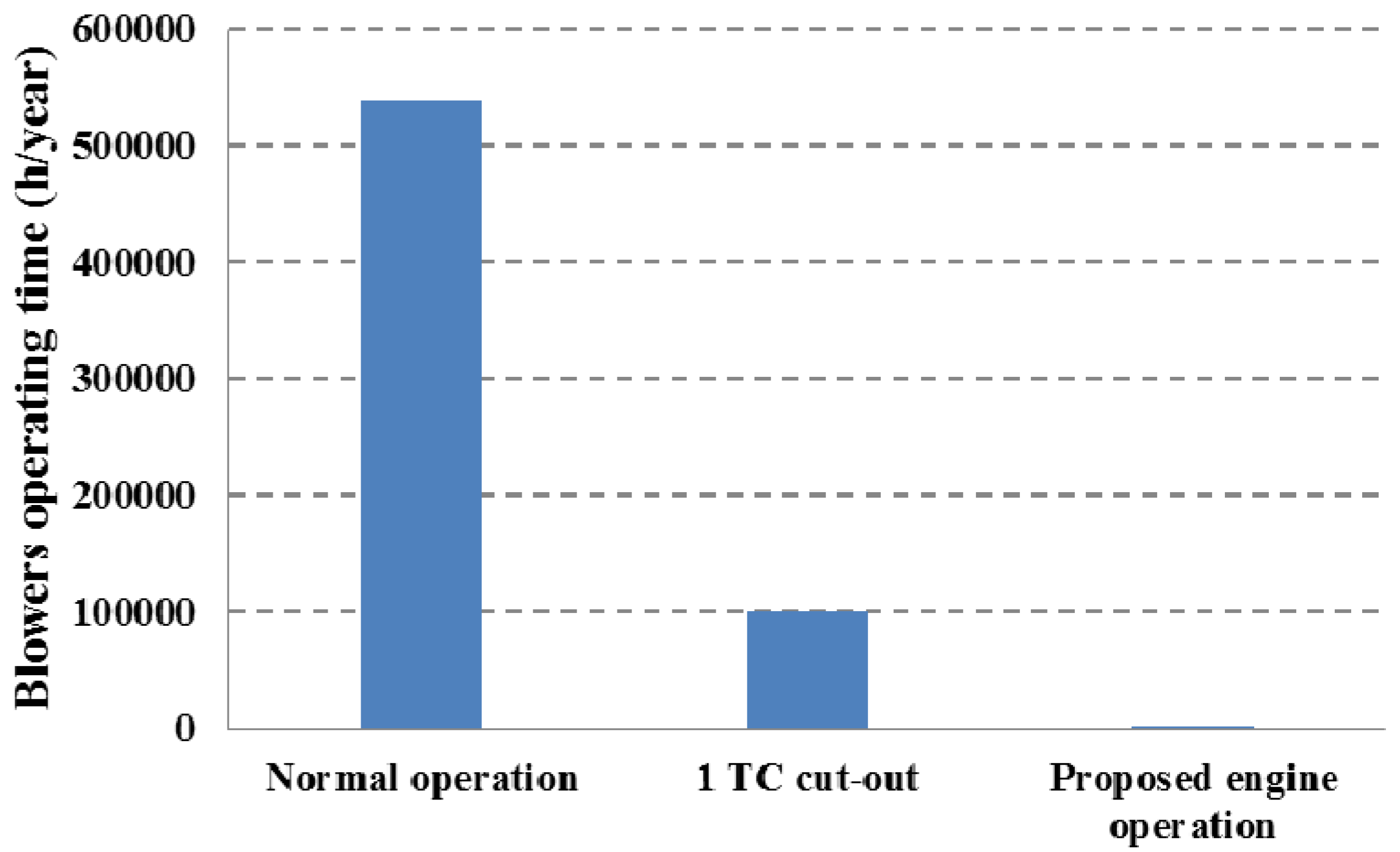
4. Conclusions
Acknowledgments
Author Contributions
Conflicts of Interest
Abbreviations
| BL | Blower |
| BDC | Bottom Dead Centre |
| CA | Crank Angle |
| EVC | Exhaust Valve Close |
| EVO | Exhaust Valve Open |
| IMO | International Maritime Organization |
| ISO | International Organization for Standardization |
| MCR | Maximum Continuous Rating |
| MVEM | Mean Value Engine Model |
| SPC | Scavenging Port Close |
| SPO | Scavenging Port Open |
| TC | Turbocharger |
| TEU | Twenty-foot Equivalent Unit |
| VIT | Variable Injection Timing |
| VLCC | Very Large Crude Carrier |
Latin Symbols
| A | Area [m2] |
| BMEP | Brake Mean Effective Pressure [bar] |
| BSFC | Brake Specific Fuel Consumption [g/kW h] |
| cv | Specific heat at constant volume [J/kg K] |
| D | Cylinder bore [m] |
| h | Specific enthalpy [J/kg], heat transfer coefficient [W/m2 K] |
| Ha | Annual operating hours (h) |
| FAs | Stoichiometric fuel-air ratio [kg fuel/kg air] |
| FC | Fuel consumption (t) |
| I | Mass moment of inertia [kg m2] |
| k | Coefficient |
| LHV | Lower heating value [kJ/kg] |
| m | Mass [kg], combustion model constant |
Mass flow rate [kg/s] | |
| N | Rotational speed [r/min] |
| p | Pressure [Pa] |
| Pb | Engine brake power [kW] |
| POT | Operating time percentage [%] |
| Q | Torque [Nm] |
Heat transfer rate [W] | |
| R | Gas constant [J/kg K] |
| t | Time [s] |
| T | Temperature [K] |
| u | Specific internal energy [J/kg] |
| V | Volume [m3] |
| w | Representative cylinder velocity (m/s) |
Greek symbols
| a | Combustion model constant |
| γ | Ratio of specific heats |
| Δθ | Crank angle duration (deg) |
| θ | Crank angle (deg) |
| λ | Air/fuel equivalence ratio |
| ξ | Burnt fuel fraction |
| φ | Fuel/air equivalence ratio |
Subscripts
| a | Air |
| cy | Cycle |
| cyl | Cylinder |
| exh | Exhaust |
| f | Fuel |
| fb | Burnt fuel |
| s | Stoichiometric |
| g | Gas |
| in | Inlet |
| IGD | Fuel injection delay |
| o | Reference point |
| out | Outlet |
| sca | Scavenging |
| sf | Surface |
| SOC | Start of combustion |
| SOI | Start of fuel injection |
References
- Carolina, G.M.; Julio, R.; Maria, J.S. Modelling and forecasting fossil fuels, CO2 and electricity prices and their volatilities. Appl. Energy 2013, 101, 363–375. [Google Scholar]
- Zhang, C.; Chen, X. The impact of global oil price shocks in China’s bulk commodity markets and fundamental industries. Energy Policy 2014, 66, 32–41. [Google Scholar] [CrossRef]
- Zhang, Y.; Wang, Z. Investigating the price discovery and risk transfer functions in the crude oil and gasoline futures markets: Some empirical evidence. Appl. Energy 2013, 104, 220–228. [Google Scholar] [CrossRef]
- Alphaliner: Container Ship Charter Rates to Weaken in 2013. Available online: https://www.joc.com/comment/1601 (accessed on 5 December 2014).
- Mandavia, M.; Bureau, E.T. Shipping industry may confront another deluge of overcapacity. Available online: http://articles.economictimes.indiatimes.com/2014-04-02/news/48801359_1_great-eastern-shipping-essar-shipping-shipping-industry (accessed on 5 December 2014).
- Analysis: Global Shipping Contends with Oversupply Problems. Available online: http://www.stratfor.com/analysis/global-shipping-contends-oversupply-problems#axzz3L2lNkuZT (accessed on 5 December 2014).
- Gcaptain. BIMCO Reflections: Oversupply Will Delay Shipping Market Recovery. Available online: http://gcaptain.com/bimco-reflections-2014-shipping-industry-analysis/ (accessed on 5 December 2014).
- International Maritime Organisation (IMO). Air Pollution and Energy Efficiency-Estimated CO2 Emissions Reduction from Introduction of Mandatory Technical and Operational Energy Efficiency Measures for Ships; IMO: London, UK, 2011; MEPC 63/INF.2. [Google Scholar]
- Haglind, F. A review on the use of gas and steam turbine combined cycles as prime movers for large ships. Part III: Fuels Emiss. Energy Convers. Manag. 2008, 49, 3476–3482. [Google Scholar]
- Pappas, C.; Karakosta, C.; Marinakis, V.; Psarras, J. A comparison of electricity production technologies in terms of sustainable development. Energy Convers. Manag. 2012, 64, 626–632. [Google Scholar] [CrossRef]
- Wärtsilä. Marine Solutions, 2nd ed.; Wärtsilä: Helsinki, Finland, 2012; Publication no: SP-EN-DBAC136254. [Google Scholar]
- MAN Diesel & Turbo. Marine Engine IMO Tier II Programme 2013; MAN Diesel & Turbo: Augsburg, Germany, 2013; Publication no. 4510-0012-00ppr. [Google Scholar]
- Brown, D. Helping shipowners cut fuel bills with Wärtsilä low-speed engines. Wärtsilä Tech. J. Mar./InDetail 2009, 1, 34–37. [Google Scholar]
- MAN Diesel & Turbo. SFOC Optimization Methods for MAN B&W Two-Stroke IMO Tier II Engines; MAN Diesel & Turbo: Augsburg, Germany, 2012; Publication no. 5510-0099-00ppr. [Google Scholar]
- MAN Diesel & Turbo. Waste Heat Recovery System (WHRS) for Reduction of Fuel Consumption, Emissions and EEDI; MAN Diesel & Turbo: Augsburg, Germany, 2012; Publication no. 5510-0136-01ppr. [Google Scholar]
- Grljušić, M.; Medica, V.; Račić, N. Thermodynamic analysis of a ship power plant operating with waste heat recovery through combined heat and power production. Energies 2014, 7, 7368–7394. [Google Scholar] [CrossRef]
- Schmid, H. Less emissions through waste heat recovery. In Proceedings of the Green Ship Technology Conference, London, UK, 28–29 April 2004; Wärtsilä Corporation: Helsinki, Finland.
- MAN Diesel & Turbo. Slide Fuel Valve; MAN Diesel & Turbo: Augsburg, Germany, 2010; Publication no. 1510-0011-03ppr. [Google Scholar]
- MAN Diesel & Turbo. Operation on Low-Sulphur Fuels; MAN Diesel & Turbo: Augsburg, Germany, 2014; Publication no. 5510-0075-01ppr. [Google Scholar]
- ABS. Ship Energy Efficiency Measures; ABS: Houston, TX, USA, 2013; Publication no: TX 05/13 5000-13015. [Google Scholar]
- Armstrong, V.N. Vessel optimisation for low carbon shipping. Ocean Eng. 2013, 73, 195–207. [Google Scholar] [CrossRef]
- Wiesmann, A. Slow steaming-a viable long-term option? Wärtsilä Tech. J. Mar./InDetail 2010, 2, 49–55. [Google Scholar]
- Pierre, C. Is slow steaming a sustainable means of reducing CO2 emissions from container shipping? Transp. Res. Part D 2011, 16, 260–264. [Google Scholar]
- Alphaliner: Slow steaming absorbs capacity. Available online: http://www.transportjournal.com/en/home/news/artikeldetail/slow-steaming-absorbs-capacity.html (accessed on 5 December 2014).
- Gard, A.S. Slow steaming on 2-stroke engines. Available online: http://www.gard.no/ikbViewer/Content/8259/No%2003-09%20Slow%20Steaming%20on%202%20stroke%20engines.pdf (accessed on 5 December 2014).
- Schmuttermair, H.; Fernandez, A.; Witt, M. Fuel economy by load profile optimized charging systems from MAN. In Proceedings of the 26th CIMAC World Congress on Combustion Engine Technology, Bergen, Norway, 14–17 June 2010. Paper no. 250.
- Baechi, R. Slow steaming and turbocharger cut-out. ABB Charge 2012, 2, 20–21. [Google Scholar]
- Woodward, J.B.; Latorre, R.G. Modeling of diesel engine transient behaviour in marine propulsion analysis. Trans. Soc. Nav. Archit. Mar. Eng. 1984, 92, 33–49. [Google Scholar]
- Hendrics, E. Mean Value Modelling of Large Turbocharged Two-Stroke Diesel Engines, SAE Technical Paper no 890564. 1989. [CrossRef]
- Chesse, P.; Chalet, D.; Tauzia, X. Real-time performance simulation of marine diesel engines for the training of navy crews. Mar. Technol. 2004, 41, 95–101. [Google Scholar]
- Theotokatos, G. On the cycle mean value modelling of a large two-stroke marine diesel engine. Proc. IMechE Part M: J. Eng. Mar. Environ. 2010, 224, 193–205. [Google Scholar] [CrossRef]
- Katrašnik, T. Transient momentum balance-A method for improving the performance of mean-value engine plant models. Energies 2013, 6, 2892–2926. [Google Scholar] [CrossRef]
- Kyrtatos, N.P.; Koumbarelis, I. Performance prediction of next-generation slow speed diesel engines during ship manoeuvers. Trans. IMarE 1994, 106, 1–26. [Google Scholar]
- Finesso, R.; Spessa, E. A real time zero-dimensional diagnostic model for the calculation of in-cylinder temperatures, HRR and nitrogen oxides in diesel engines. Energy Convers. Manag. 2014, 79, 498–510. [Google Scholar] [CrossRef]
- Catania, A.E.; Finesso, R.; Spessa, E. Predictive zero-dimensional combustion model for DI diesel engine feed-forward control. Energy Convers. Manag. 2011, 52, 3159–3175. [Google Scholar] [CrossRef]
- Asad, U.; Tjong, J.; Zheng, M. Exhaust gas recirculation–zero dimensional modelling and characterization for transient diesel combustion control. Energy Convers. Manag. 2014, 86, 309–324. [Google Scholar] [CrossRef]
- Chmela, F.G.; Pirker, G.H.; Wimmer, A. Zero-dimensional ROHR simulation for DI diesel engines–A generic approach. Energy Convers. Manag. 2007, 48, 2942–2950. [Google Scholar] [CrossRef]
- Xiros, N. Robust Control of Diesel Ship Propulsion; Springer-Verlag London Ltd.: London, UK, 2002. [Google Scholar]
- Theotokatos, G.; Tzelepis, V. A computational study on the performance and emission parameters mapping of a ship propulsion system. Proc. IMechE Part M: J. Eng. Mar. Environ. 2015, 229, 58–76. [Google Scholar] [CrossRef]
- Livanos, G.A.; Papalambrou, G.; Kyrtatos, N.P.; Christou, A. Electronic engine control for ice operation of tankers. In Proceedings of the 25th CIMAC World Congress on combustion Engine Technology, Vienna, Austria, 21–24 May 2007. Paper no. 44.
- Guan, C.; Theotokatos, G.; Zhou, P.; Chen, H. Computational investigation of a large containership propulsion engine operation at slow steaming conditions. Appl. Energy 2014, 130, 370–383. [Google Scholar] [CrossRef]
- Hountalas, D.T.; Sakellaridis, N.F.; Pariotis, E.; Antonopoulos, A.K.; Zissimatos, L.; Papadakis, N. Effect of turbocharger cut out on two-stroke marine diesel engine performance and NOx emissions at part load operation. In Proceedings of the ASME 12th biennial conference on engineering systems design and analysis, Copenhagen, Denmark, 25–27 July 2014. ESDA2014-20514.
- Kyrtatos, N.; Glaros, S.; Tzanos, E.; Hatzigrigoris, S.; Dalmyras, F. Systematic evaluation of performance of VLCC engine, comparing service monitored data and thermodynamic model predictions. In Proceedings of the 27th CIMAC World Congress on Combustion Engine Technology, Shanghai, China, 13–16 May 2013. Paper no. 32.
- Heywood, J.B. Internal Combustion Engines Fundamentals; Mc-Graw-Hill: New York, USA, 1988. [Google Scholar]
- Watson, N.; Janota, M.S. Turbocharging the Internal Combustion Engine; MacMillan: London, UK, 1982. [Google Scholar]
- Merker, G.P.; Schwarz, C.; Stiesch, G.; Otto, F. Simulating Combustion; Springer-Verlag: Berlin, Germany, 2006. [Google Scholar]
- Klein, M. Single-Zone Cylinder Pressure Modeling and Estimation for Heat Release Analysis of SI Engines. Ph.D. Dissertation, Linköping University, Linköping, Sweden, 2007. [Google Scholar]
- Woschni, G. A Universally Applicable Equation for the Instantaneous Heat Transfer Coefficient in the Internal Combustion Engine, SAE Paper no 670931. 1967. [CrossRef]
- Ciulli, E. A Review of Internal Combustion Engine Losses. Part 2: Studies for Global Evaluations. Proc. Inst. Mech. Eng. 1992, 207, 229–240. [Google Scholar] [CrossRef]
- Merker, G.; Gerstle, M. Evaluation on Two Stroke Engines Scavenging Models, SAE Technical Paper no 970358. 1997. [CrossRef]
- MAN Diesel & Turbo. MAN B&W K98MC Project Guide: Two-Stroke Engines, 3rd ed.; MAN Diesel & Turbo: Augsburg, Germany, 2002. [Google Scholar]
- MAN Diesel & Turbo. Propulsion Trends in Container Vessels; MAN Diesel & Turbo: Augsburg, Germany, 2013; No. 5510-0040-02ppr. [Google Scholar]
- Banks, C.; Turan, O.; Incecik, A.; Theotokatos, G.; Izkan, S.; Shewell, C.; Tian, X. Understanding ship operating profiles with an aim to improve energy efficient ship operations. In Proceedings of the Low Carbon Shipping Conference, London, UK, 9–10 September 2013.
- MAN Diesel & Turbo. Basic Principles of Ship Propulsion; MAN Diesel & Turbo: Augsburg, Germany, 2011; No. 5510-0004-02ppr. [Google Scholar]
- International Maritime Organisation (IMO). Third IMO GHG Study; IMO: London, UK, 2014; MEPC 67/INF.3. [Google Scholar]
© 2015 by the authors; licensee MDPI, Basel, Switzerland. This article is an open access article distributed under the terms and conditions of the Creative Commons Attribution license (http://creativecommons.org/licenses/by/4.0/).
Share and Cite
Guan, C.; Theotokatos, G.; Chen, H. Analysis of Two Stroke Marine Diesel Engine Operation Including Turbocharger Cut-Out by Using a Zero-Dimensional Model. Energies 2015, 8, 5738-5764. https://doi.org/10.3390/en8065738
Guan C, Theotokatos G, Chen H. Analysis of Two Stroke Marine Diesel Engine Operation Including Turbocharger Cut-Out by Using a Zero-Dimensional Model. Energies. 2015; 8(6):5738-5764. https://doi.org/10.3390/en8065738
Chicago/Turabian StyleGuan, Cong, Gerasimos Theotokatos, and Hui Chen. 2015. "Analysis of Two Stroke Marine Diesel Engine Operation Including Turbocharger Cut-Out by Using a Zero-Dimensional Model" Energies 8, no. 6: 5738-5764. https://doi.org/10.3390/en8065738







